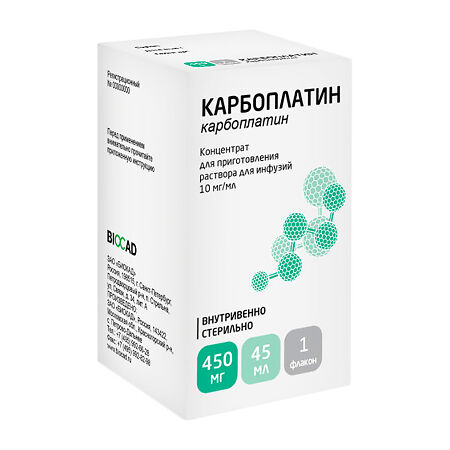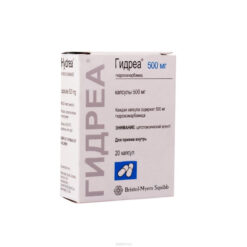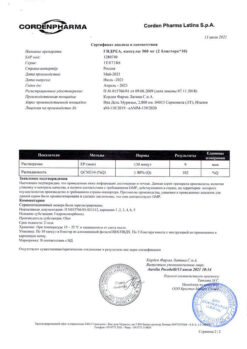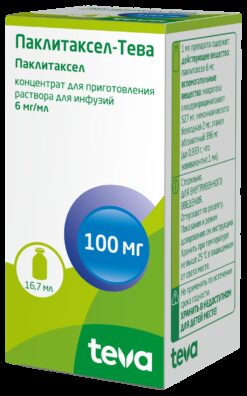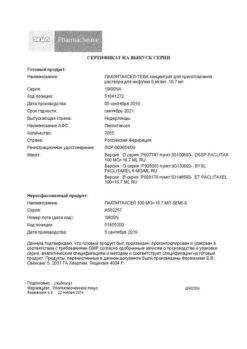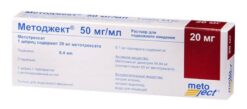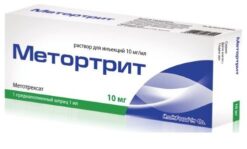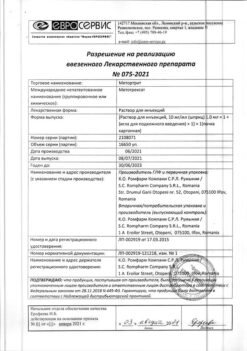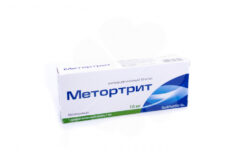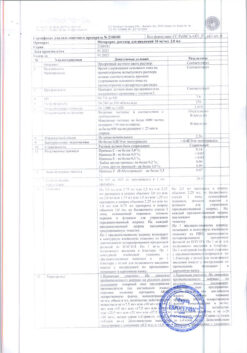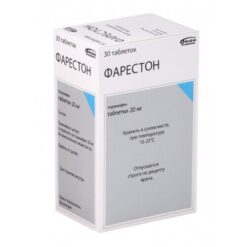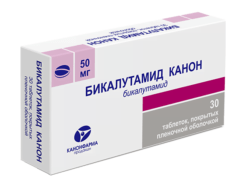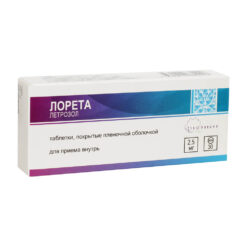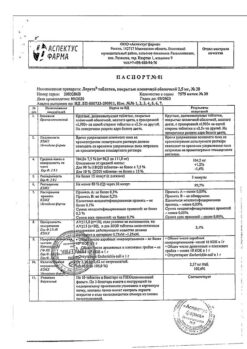No products in the cart.
Description
Pharmacotherapeutic group: Antitumor agent, alkylating compound.
ATX code: L01XA2
Pharmacological properties
Pharmacodynamics
Carboplatin is an inorganic complex compound containing the heavy metal – platinum. The main mechanism of action is the drug’s binding to DNA, as a result of which mainly intraspiral cross-links are formed, which change the structure of DNA and inhibit its synthesis (prevent DNA strands separation). This effect appears regardless of the phase of the cell cycle. Hydration of carboplatin, which produces the active form(s) of the drug, is slower than hydration of cisplatin. Despite this, carboplatin and cisplatin cause the same amount of cross-linking in DNA and have equivalent biological effects.
Pharmacokinetics
In intravenous administration, the plasma concentration of carboplatin is dose-dependent in the range of 20-500 mg/m2 and decreases biphasically. Average retention time of carboplatin in plasma is 3.5 hours. In blood plasma concentrations of platinum in carboplatin molecule are much higher than concentrations of free platinum. Half-life period of free platinum after intravenous injection of carboplatin in doses of 20-1600 mg/m2 for 30-60 minutes is 83-96 minutes. Volume of distribution is 16-20 liters. The highest concentrations of carboplatin accumulate in the liver, kidneys, skin and tumors. Maximum concentrations of platinum are found in liver and lungs. Less than 10% of carboplatin binds to plasma proteins, about 24% of platinum binds to plasma proteins in the first 4 hours and up to 40-87% within 24 hours after administration of carboplatin.
The initial metabolic products of carboplatin can be mono- and dihydrated diamine-platinum compounds. These metabolites are highly reactive and bind firmly to the sulfide groups of plasma proteins.
Carboplatin is excreted primarily by the kidneys. Most of the platinum is excreted in the first 6 hours. After 24 hours the excretion of carboplatin decreases to 2% of the dose or less per day. About 50% of carboplatin is eliminated unchanged. Cumulative urinary excretion is independent of the dose, but decreases with increasing severity of renal impairment. In patients with creatinine clearance less than 60 ml/min, the drug doses should be reduced.
The pharmacokinetic parameters of carboplatin in children are similar to those in adults. Because elderly patients may have impaired renal function, doses of carboplatin should be reduced.
Indications
Indications
Germ cell tumors of men and women.
Ovarian cancer.
Cervical cancer.
Transitional cell carcinoma of the bladder.
Lung cancer.
Malignant tumors of the head and neck.
Pharmacological effect
Pharmacological effect
Pharmacotherapeutic group: Antitumor agent, alkylating compound.
ATX code: L01ХА2
Pharmacological properties
Pharmacodynamics
Carboplatin is an inorganic complex compound containing the heavy metal platinum. The main mechanism of action is the binding of the drug to DNA, as a result of which predominantly intrahelical cross-links are formed, which change the structure of DNA and suppress its synthesis (prevent the separation of DNA strands). This effect occurs regardless of the phase of the cell cycle. The hydration of carboplatin to the active form(s) of the drug occurs more slowly than the hydration of cisplatin. Despite this, carboplatin and cisplatin cause the same number of DNA crosslinks and have equivalent biological effects.
Pharmacokinetics
When administered intravenously, the concentration of carboplatin in blood plasma is dose-dependent in the range of 20-500 mg/m2 and decreases in two phases. The average residence time of carboplatin in blood plasma is 3.5 hours. In blood plasma, the concentrations of platinum in the carboplatin molecule significantly exceed the concentrations of free platinum. The half-life of free platinum after intravenous administration of carboplatin in doses of 20-1600 mg/m2 over 30-60 minutes ranges from 83-96 minutes. The distribution volume is 16-20 l. The highest concentrations of carboplatin accumulate in the liver, kidneys, skin and tumors. Maximum concentrations of platinum were found in the liver and lungs. Less than 10% of carboplatin is bound to plasma proteins, about 24% of platinum is bound to plasma proteins in the first 4 hours and up to 40-87% within 24 hours after the start of carboplatin administration.
The initial products of carboplatin metabolism can be mono- and dihydrated diamineplatinum compounds. These metabolites are highly reactive and bind strongly to sulfide groups of plasma proteins.
Carboplatin is excreted primarily by the kidneys. Most of the platinum is excreted in the first 6 hours. After 24 hours, carboplatin excretion is reduced to 2% of the dose or less per day. About 50% of carboplatin is eliminated unchanged. Cumulative urinary excretion is independent of dose but decreases with increasing severity of renal impairment. In patients with creatinine clearance less than 60 ml/min, the dose of the drug should be reduced.
The pharmacokinetic parameters of carboplatin in children are similar to those in adults. Since renal function may be impaired in elderly patients, it is recommended to reduce the dose of carboplatin.
Special instructions
Special instructions
The administration of Carboplatin-Ebeve should be carried out under the supervision of a physician experienced in the use of cytotoxic drugs. Constant monitoring of possible toxic effects during treatment with Carboplatin-Ebeve is mandatory, especially when using high doses of the drug.
Do not use needles, syringes, catheters and infusion systems containing aluminum for the preparation and administration of the drug, which can react with carboplatin, leading to the formation of sediment or loss of activity of the drug. Clinical blood tests, renal function (creatinine clearance) and liver function should be monitored regularly (once a week).
Nausea and vomiting develop 6-12 hours after administration of the drug Carboplatin-Ebeve and continue for 24 hours (prescription of antiemetics is necessary). Periodic neurological examinations are recommended, especially in elderly patients (over 65 years of age) and those previously treated with platinum-containing drugs.
Since Carboplatin-Ebeve can cause ototoxic effects (manifested by a decrease in the hearing threshold at high frequencies), patients are recommended to undergo audiographic studies before and during treatment. In case of clinically significant impairment of hearing function, an appropriate change in the dose of Carboplatin-Ebeve or discontinuation of treatment may be required.
During treatment with Carboplatin-Ebeve and for at least 3 months after, it is not recommended to vaccinate patients.
Women and men should use reliable methods of contraception during treatment with Carboplatin-Ebeve and for at least 6 months after the end of treatment.
If Carboplatin-Ebeve comes into contact with the skin or mucous membranes, rinse thoroughly with water (mucous membranes) or soap and water (skin). Dissolution, dilution and administration of the drug is carried out by trained medical personnel in compliance with protective measures (gloves, masks, clothing, etc.).
Residues of the drug and all instruments and materials used to prepare Carboplatin-Ebeve infusion solutions should be disposed of in accordance with standard hospital cytotoxic waste disposal procedures, taking into account applicable hazardous waste disposal regulations.
Information about the possible effect of Carboplatin-Ebeve on the ability to drive vehicles and machinery
Due to the likelihood of side effects such as nausea, vomiting, drowsiness, caution should be exercised when engaging in potentially hazardous activities that require increased concentration and speed of psychomotor reactions.
Active ingredient
Active ingredient
Carboplatin
Composition
Composition
1 ml of concentrate contains:
Active substance:
carboplatin 10 mg
Excipients:
sodium dihydrogen phosphate anhydrous – 1.2 mg,
sodium hydroxide – to pH,
water for injection – 994.30 mg.
Pregnancy
Pregnancy
There are no controlled studies of the use of carboplatin in pregnant women. Animal studies have shown embryotoxic, teratogenic and mutagenic effects of carboplatin. Therefore, pregnant women should not use carboplatin.
It is not known whether carboplatin passes into breast milk, therefore, to avoid toxic effects of platinum on the infant, breastfeeding should be discontinued during treatment.
Contraindications
Contraindications
hypersensitivity to carboplatin or other platinum-containing compounds;
severe renal dysfunction (creatinine clearance less than 15 ml/min);
severe myelosuppression;
heavy bleeding;
pregnancy and lactation;
children’s age (safety and effectiveness have not been studied enough). With caution
Use with caution in patients with suppressed bone marrow hematopoietic function (including during concomitant radiation and chemotherapy), impaired renal function; impaired function of the hearing aid; receiving treatment with nephrotoxic drugs (for example, cisplatin), acute infectious diseases of a viral, fungal or bacterial nature, in the post-vaccination period.
Side Effects
Side Effects
The incidence of side effects is presented in accordance with the following gradation: very common – >10%, frequent – >1% 0.1% 0.01%
From the hematopoietic organs: very common: suppression of the function of bone marrow hematopoiesis (dose-dependent). The lowest level of platelets and leukocytes/granulocytes is usually achieved 2-3 weeks after starting the drug, and thrombocytopenia is more common. Adequate recovery to a level allowing the next dose of Carboplatin usually takes at least 4 weeks.
Anemia (hemoglobin level less than 11 g/dL). Transfusion therapy may be necessary, especially in patients undergoing long-term treatment (eg, more than 6 cycles of the drug). Leukopenia and neutropenia usually occur 42 days after the start of therapy.
From the gastrointestinal tract:
very common: nausea, vomiting, increased activity of “liver” transaminases;
common: inflammation of the oral mucosa, diarrhea, constipation, abdominal pain, increased concentrations of bilirubin and alkaline phosphatase in the blood serum;
rare – colitis, including pseudomembranous colitis.
From the central nervous system:
common: peripheral neuropathy (paresthesia, decreased deep tendon reflexes, which is more likely in patients over 65 years of age), headache, dizziness, meningismus, depression, insomnia;
uncommon: increased nervousness;
very rare: stroke.
Neurotoxicity is a dose-limiting adverse effect. Symptoms of sensory neuropathy are often triggered by cold. The duration of these symptoms, which usually resolve between courses, increases depending on the total dose of carboplatin. Functional impairment, which is characterized by difficulty performing precise movements, is a possible consequence of sensory damage.
From the organs of hearing and vision:
very common: ototoxicity (tinnitus, hearing loss);
rare: temporary visual impairment (possible loss of ability to distinguish colors and see light). Improvement and/or complete restoration of vision usually occurs within a few weeks after stopping the drug.
very rare: complete loss of vision, loss of hearing.
From the genitourinary system:
very common: temporary increase in serum creatinine and urea concentrations;
rare: acute renal failure, hemolytic-uremic syndrome (Gasser syndrome – acute renal failure with oliguria, hemolytic anemia and thrombocytopenia).
On the electrolyte balance side:
rare: hypokalemia, hypocalcemia, hyponatremia, hypomagnesemia. Allergic reactions
common: erythematous rash, fever, itching, urticaria, bronchospasm, arterial hypotension, anaphylactic reactions, conjunctivitis, rhinitis;
very rare: exfoliative dermatitis.
Other:
common: alopecia, asthenia, arthralgia, intermittent fever;
uncommon: infectious complications, taste disturbances, allergic reactions directly at the injection site, pain, redness, swelling.
very rare: necrosis.
Interaction
Interaction
The use of carboplatin in combination with other myelosuppressive drugs or radiation therapy may increase the risk of hematological toxicity. Concomitant therapy with aminoglycosides, as well as other nephrotoxic and ototoxic drugs, potentiates the toxic effect of carboplatin on these organs.
Carboplatin may react with aluminum to form a black precipitate.
Overdose
Overdose
Symptoms: pronounced manifestation of the above side effects.
Treatment: no antidote is known. Treatment is symptomatic. In the first 3 hours after administration of the drug, hemodialysis may be used.
Storage conditions
Storage conditions
In a place protected from light, at a temperature not exceeding 25 ° C.
Keep out of the reach of children.
Shelf life
Shelf life
3 years.
Do not use after the expiration date stated on the package.
Manufacturer
Manufacturer
Biocad, Russia
Additional information
| Shelf life | 3 years. Do not use after the expiration date shown on the package. |
|---|---|
| Conditions of storage | In the dark place at a temperature not exceeding 25 ° C. Keep out of reach of children. |
| Manufacturer | Biocad, Russia |
| Medication form | concentrate for preparation of infusion solution |
| Brand | Biocad |
Related products
Buy Carboplatin, 10 mg/ml 45 ml with delivery to USA, UK, Europe and over 120 other countries.

